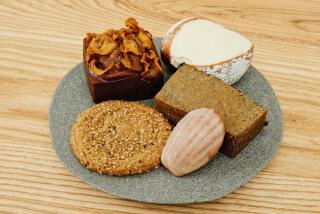The best Vietnamese coffee in Little Saigon? Try these new cafes
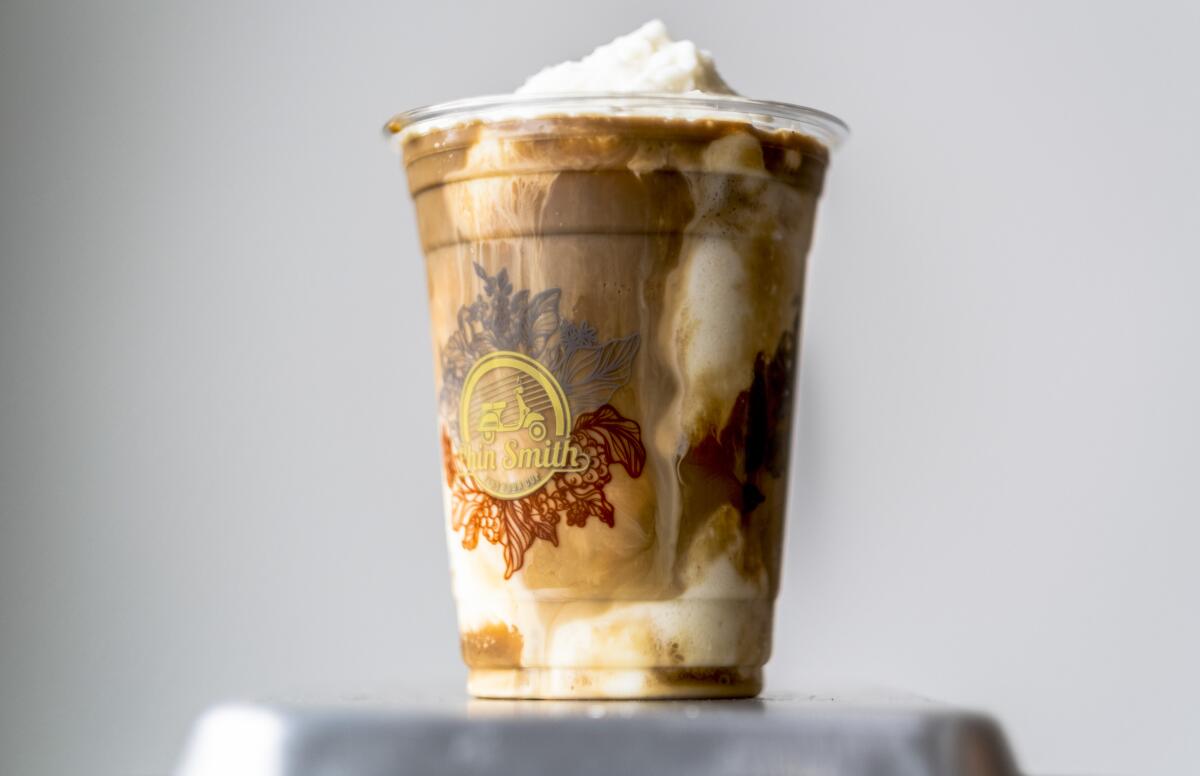
Viet Do still remembers his first taste of real Vietnamese coffee: rich, nutty, chocolatey, slightly smoky, baritone in flavor with a powerful jolt of caffeine.
This was not the creamy-sweet plastic straw staple that Do, 37, had grown up on in Orange County, but coffee grown in the Central Highlands of Vietnam, brewed using a phin, a traditional metal drip filter.
“It was so smooth and full-bodied, and the taste was incredible,” he recalls.
Do’s epiphany came during his first trip to Vietnam, about eight years ago. Born and raised in Garden Grove, Do had long wanted to visit the country his parents had emigrated from after the Vietnam War.
The most memorable moment of the trip, he said, came when he and longtime friend Henry Ngo, 38, toured Buôn Ma Thuột, a city known as Vietnam’s “coffee capital,” home to a unique growing climate and rich volcanic soils famous for producing the country’s most prized beans.
Ngo, who was born in Vietnam and immigrated to the U.S. as a child, had something of an inside track: His family had worked as coffee roasters for three generations before relocating to the U.S. The two friends toured coffee farms, chatted with roasters, and drank heroic amounts of strong, dark coffee at local cafés.
Do and Ngo returned to Orange County inspired and struck up a plan to open a café that reflected the culture and craft they’d experienced in Vietnam.
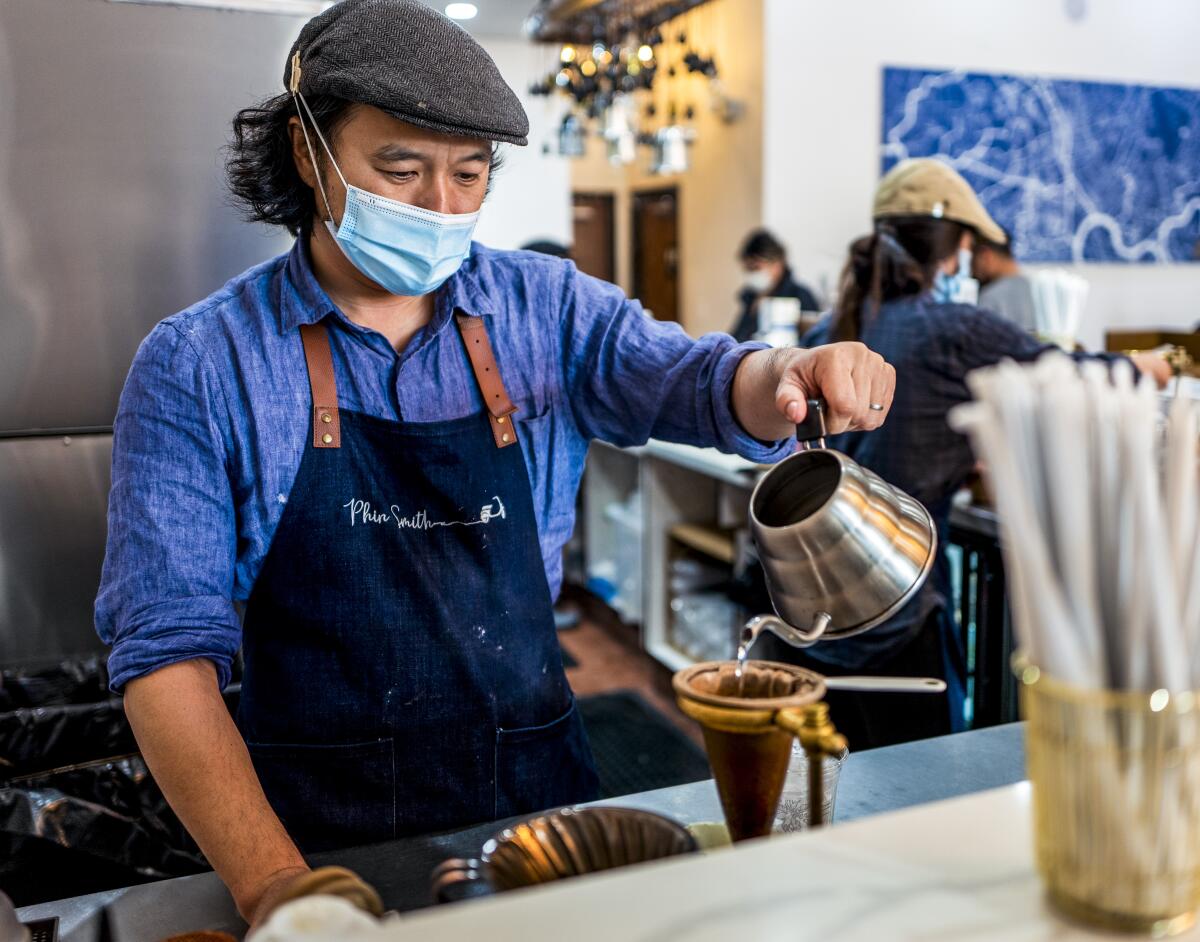
A few years later, at the end of 2018, they and their business partner Xuan Ton opened Phin Smith, a coffee shop on a quiet stretch of Garden Grove’s historic Main Street where every drink would be “brewed by hand” using traditional methods.
On the surface, Phin Smith might have seemed like just another café on the periphery of Little Saigon, the sprawling Vietnamese American enclave in Orange County, home to more purveyors of Vietnamese coffee anywhere outside Vietnam. But Do and Ngo were doing something different. They’d struck a deal with a farming company they’d encountered in Buôn Ma Thuột and were importing green coffee beans directly from Vietnam and roasting it themselves.
Surprisingly, that was a rarity in Little Saigon.
Do believes that extra effort is what has set them apart with customers. After three years in business, the shop maintains a perfect 5-star rating on Yelp with over 900 reviews, and is often heralded in online food communities as serving the best Vietnamese coffee in Southern California.
Try trendy and inventive takes on Vietnamese coffee across L.A. and Orange County, including blended coconut coffee and egg coffee topped with salted egg yolk.
“God-tier cafe sua da,” commented Ns1 on the restaurant discussion board Food Talk Central in 2019. “Not too sweet, real nice nutty after taste. Just fantastic.”
Though it might lay claim to the most passionate fans, Phin Smith is not the only business elevating the conversation around Vietnamese coffee. Recently, a wave of ambitious Orange County cafés has found new inspiration in Vietnam’s unique coffee culture, showcasing specialty roasts and reimagining traditional drinks for a local audience that is thirsty for both creativity and authenticity.
The buzz is palpable — and that’s not just the caffeine talking.
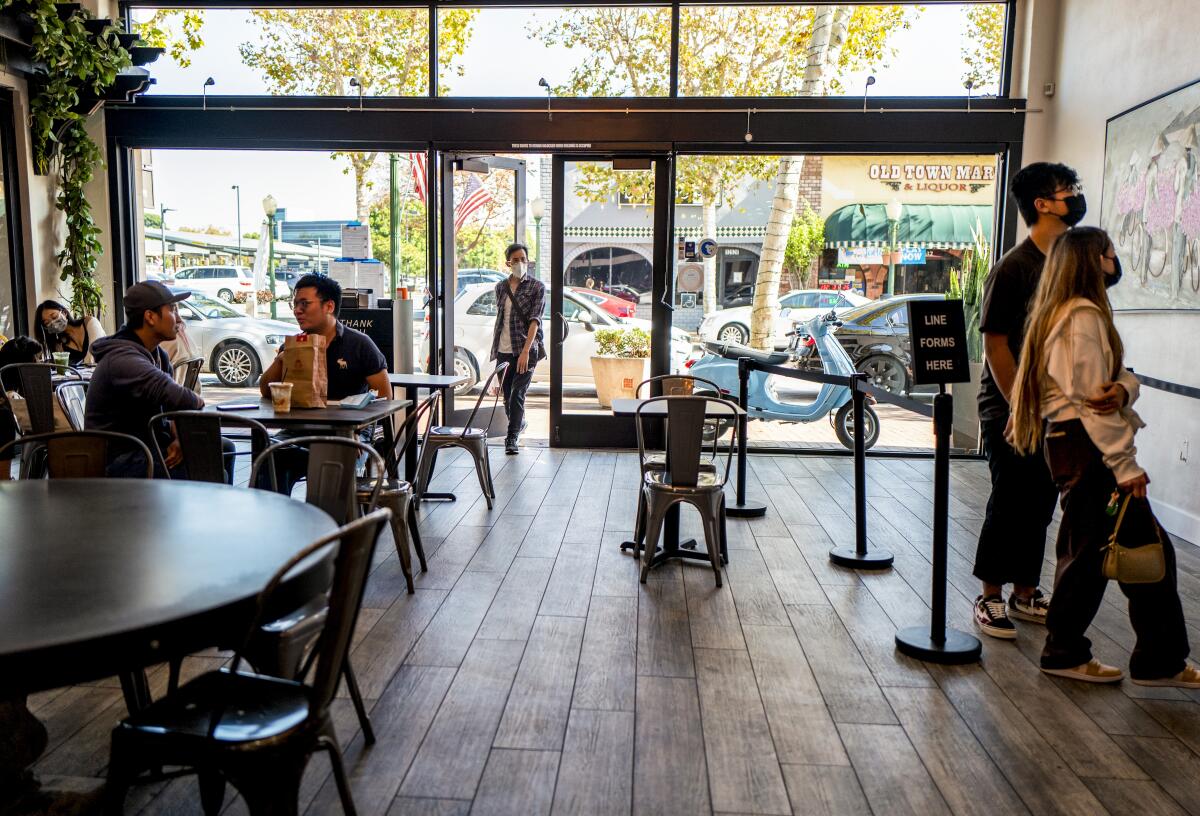
A new take on an old style
Cà phê sua dá — a shot of high-octane coffee mixed with sweetened condensed milk over ice — could well be described as the unofficial official beverage of Little Saigon.
It’s a fixture of both mom-and-pop noodle shops and international boba chains, minuscule bakeries wedged next to laundromats and upscale fusion restaurants with fancy menus. It’s the crucial counterpart to a crunchy banh mi smeared with paté, or a bowl of pho heaped with fresh herbs.
More recently, as the drink has spilled into mass-market consciousness, it’s appeared at coffee shops that might otherwise have no connection to Vietnam or Asia. Starbucks customers can order an ersatz version off the chain’s “secret menu”: triple espresso with a generous squirt of white mocha sauce and heavy cream.
Though not all Vietnamese coffees are created equal, many of them do share a rather unexpected trait — the vast majority of “Vietnamese coffee” in America is not made using beans from Vietnam, despite the country being the world’s second largest producer of coffee.
Why the discrepancy? Blame the long tail of colonialism and a quirk of globalization.
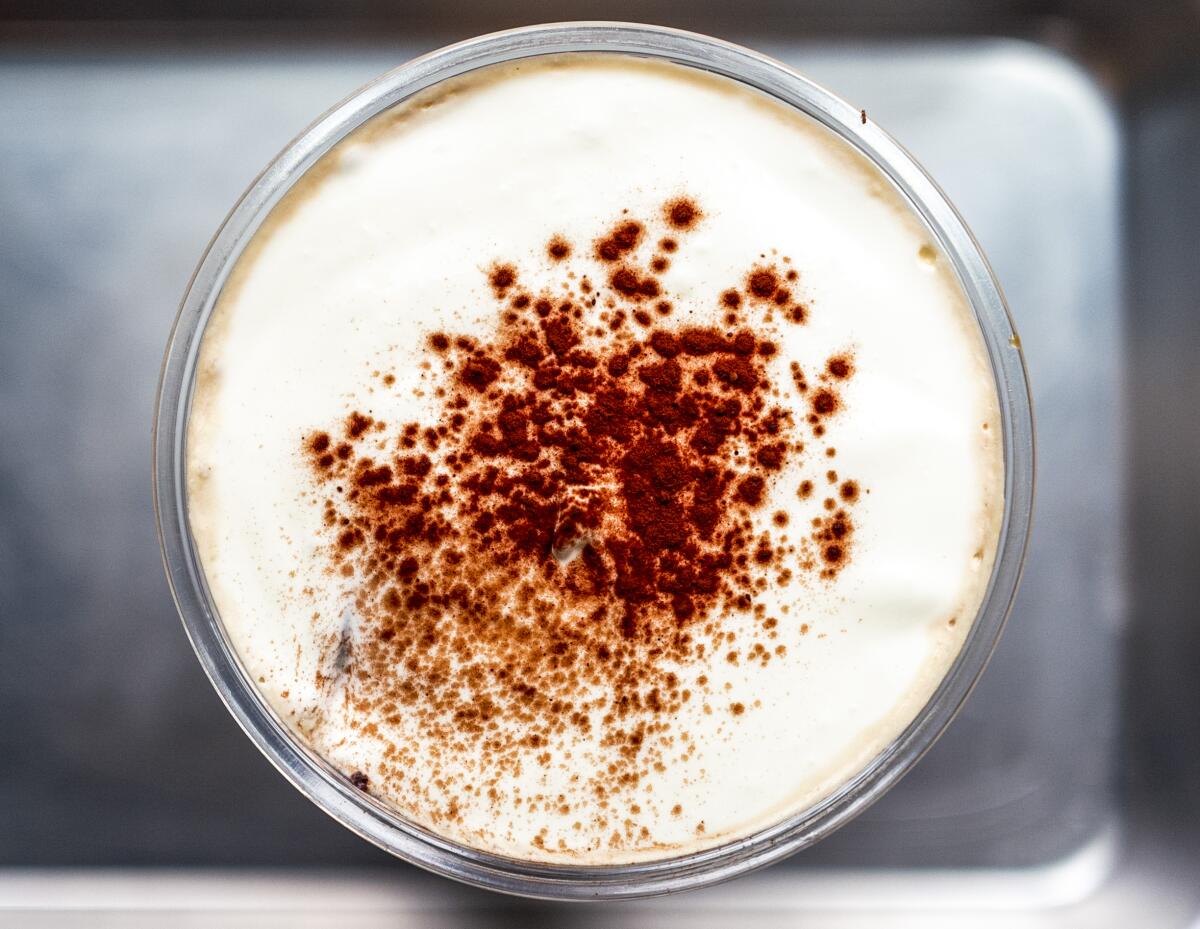
The French, who occupied Vietnam for nearly a century, introduced coffee in the mid-1800s, seeking to cultivate a crop that could fulfill a lucrative demand for beans in Europe.
The lasting colonial presence instilled in Vietnam a taste for coffee as it was consumed in France: strong, dark-roasted coffees brewed using a single-serve method somewhere between a French press and a pour-over. Eventually, boulevards in cities such as Saigon (now Ho Chi Minh City) and Hanoi became crowded with cafés where patrons would sip coffees mellowed with sweetened condensed milk, a substitution that arose due to the high cost of fresh dairy.
Yet Vietnamese farmers quickly discovered that while Coffea arabica, the most widely cultivated coffee species in the world, didn’t grow particularly well in the country’s humid climate, another heartier variety, Coffea robusta, thrived.
Robusta beans contain twice the caffeine and antioxidants of Arabica, but half the amount of sugar and oils, which impart flavor to the beans once they’re roasted. This, in part, has made Arabica the more prized variety worldwide, known for its sweetness and aroma in contrast to the earthy, intense flavors of Robusta.
At some point, this perception of inferiority became a self-fulfilling prophecy in the global coffee industry, said Sahra Nguyen, the founder of Nguyen Coffee Supply, a Brooklyn-based roaster that bills itself as the first specialty Vietnamese coffee importer and roaster in the United States.
Little Saigon cafes and coffee shops are pushing caffeinated culture to new heights.
Since Robusta — which accounts for 90% of the coffee grown in Vietnam — often sold for far less than Arabica, farmers were forced to harvest ever larger volumes to remain profitable, creating an emphasis on quantity over quality, which dropped prices further.
According to Nguyen, among large-scale coffee buyers in the West, Vietnamese exports developed a reputation for low-grade beans — stuff that tasted like burnt rubber and kicked like rocket fuel — suitable for use in cheap blends or instant coffees produced by companies such as Nestlé.
“When you talk about specialty coffee as it exists in Central or South America or Africa, there hasn’t been the same interest in improving or elevating Vietnamese coffee, because there are [large companies] that have a vested interest in the keeping the prices artificially low,” said Nguyen.
“There are so many farmers who want to break out of this cycle of poverty, and who invest time and education and labor into growing a better product, but at the end of the season, they’re not finding specialty buyers for their green [unroasted] coffee.”
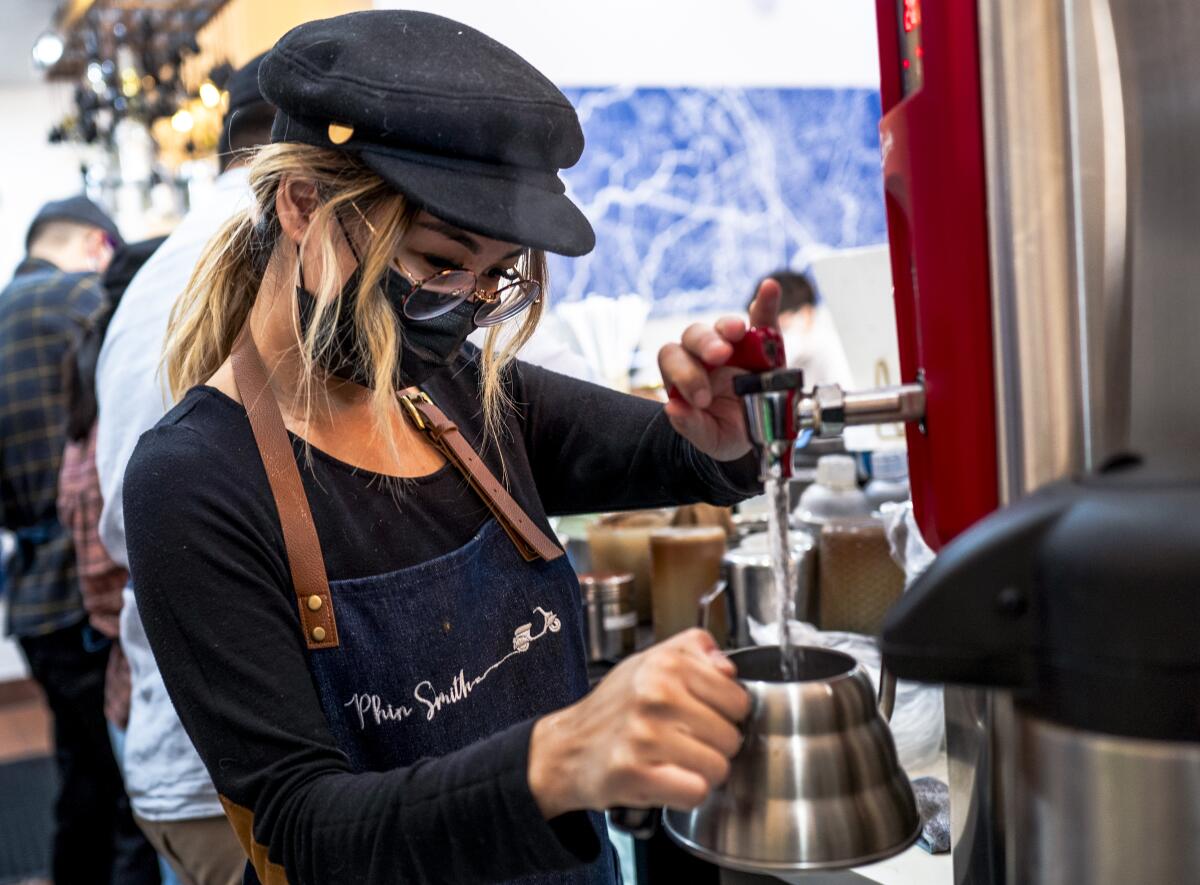
Since launching her company in 2018, Nguyen has emerged as the leading voice for Vietnamese craft coffee in the U.S., applying the rigorous sourcing and roasting practices of so-called “third-wave coffee” to bold Robusta beans and helping create a farmer-to-roaster direct trade pipeline that hadn’t existed previously.
Over the last few years, Vietnamese craft coffee shops have sprung up in cities such as Seattle, Austin, Portland, Philadelphia, Chicago and Kansas City, many of them run by first- and second-generation immigrants. They represent a growing contingent of coffee professionals working to rehabilitate the reputation of Robusta — those who believe the problem is not with the beans themselves, but the way in which they’re valued.
“It’s clear to me that Robusta is the future specialty coffee and the awareness around it is only going to continue to grow,” Nguyen said. “I’ve talked to so many baristas who are rethinking this perception of Robusta and realizing it deserves to be part of the conversation.”
So should only coffee made from Robusta beans be considered Vietnamese coffee? Nguyen doesn’t go that far — in fact, a blend of single-origin Arabica and Robusta beans is her company’s best seller. But she does believe that the recognition of Vietnam as a region capable of producing world-class coffees, of any variety, is an important step in making quality exports available to more drinkers in the U.S.
It’s that lack of availability, after all, that has traditionally steered tastes in immigrant communities such as Little Saigon.
“When I was growing up, most places used Gaviña coffee, which are Arabica [beans], because they had the closest to that strong dark flavor” said Do, referring to the Cuban American brand based in Vernon whose smoky French Roast is known as a mainstay of Southern California’s Vietnamese American community. “There was nowhere you could buy Robusta beans in general, never mind high-quality ones.”
These days you can find bags of pre-ground Trung Nguyên coffee — the largest coffee brand in Vietnam — stocked in many Asian supermarkets, but the reputation of the past has been hard to shake, especially among the older generation of cafés, the majority of which still use Arabica.
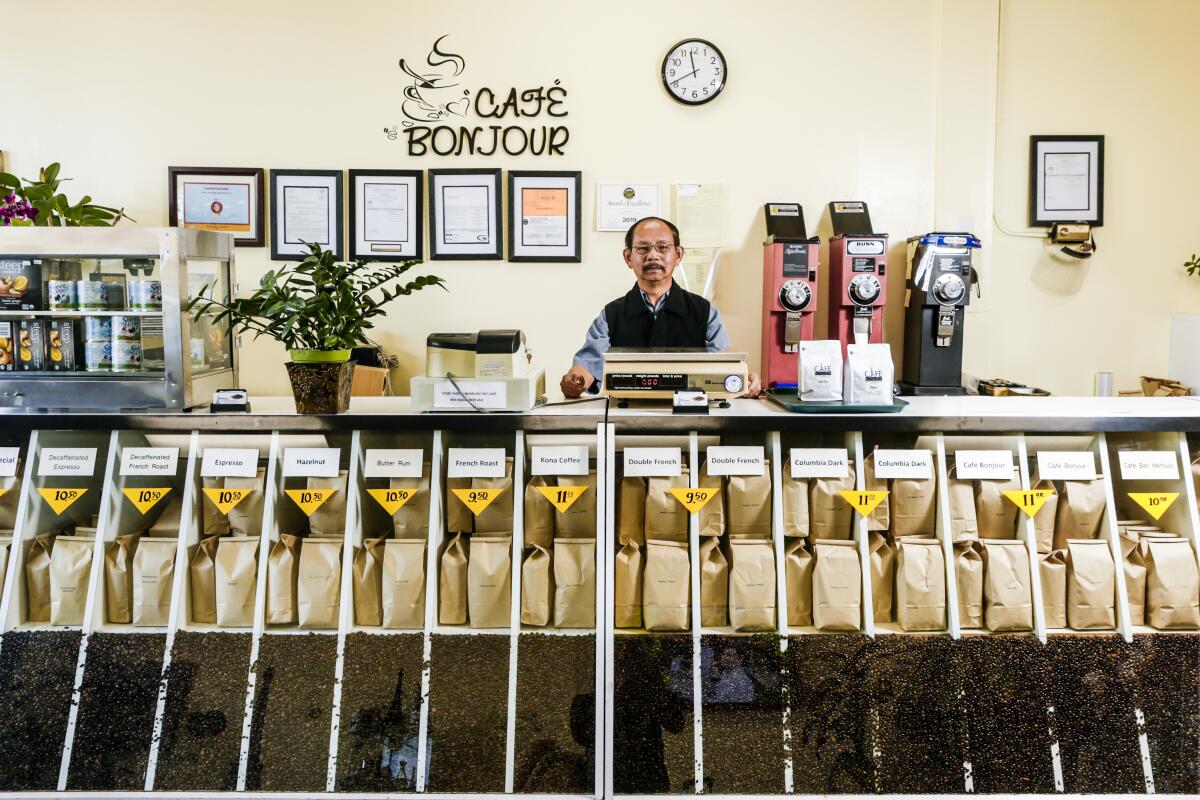
Bach Linh Tran, the semi-retired owner of Café Bonjour, a small coffee roaster in Garden Grove that supplies many local bakeries and restaurants and has been in operation since 1995, can be included in that group. Among the two dozen freshly-roasted coffees he sells by the pound at his strip mall storefront — including a Buôn Ma Thuột-inspired blend — not one comes from Vietnam. It’s too difficult to find beans from Vietnam, he said. Instead, he prefers Arabicas from Brazil or Colombia, which are readily available. Even more surprising? Before emigrating from Vietnam in the 1970s, Tran worked as a coffee farmer.
At Phin Smith, Do and Ngo faced similar logistical challenges as Nguyen did when she launched her business. In order to export green coffee, they partnered with a wholesale distributor, Phuong Vy, that owned farms in Buôn Ma Thuột but rarely sold its top-grade unroasted beans outside the country.
Do and Ngo arranged to purchase “the best coffees they had” and shipped them over a container at a time, roasting it at a facility in Westminster twice a week. The intricate process had its hiccups — Phin Smith was forced to close for two weeks last year after it ran out of coffee due to a supply chain crunch.
“It all comes down to the roasting process,” said Do. “Robusta is a very delicate coffee, so you have to roast it enough to bring out the nutty flavor, but not so much that it becomes bitter. That’s the difference between bad Vietnamese coffee and great.”
‘We’re doing something different’
Chef and restaurateur Viet Nguyen, 35, faced a difficult decision when the pandemic arrived in 2020. His most recent restaurant, a Southeast Asian tasting menu concept in Fountain Valley called Gem Dining, had closed temporarily and he needed something to keep staff employed.
“I knew that people weren’t able to travel to Asia at that time, so I thought let’s bring Asia to them,” said Nguyen, who also owns Súp Noodle Bar and Vox Kitchen in Orange County.
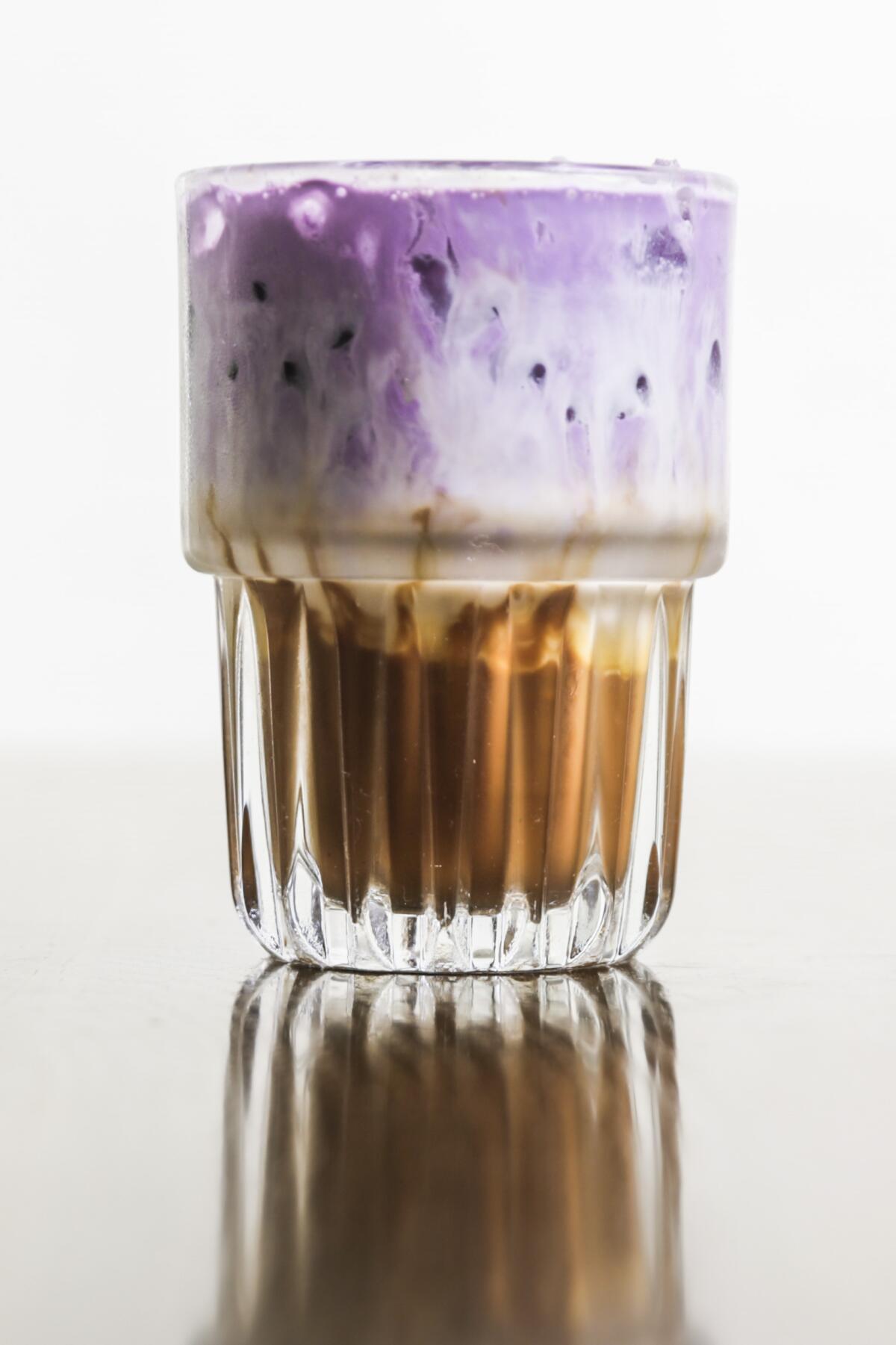
In August 2020, Nguyen transformed Gem’s patio into Nep Café, an outdoor brunch pop-up inspired by the sidewalk cafés of Vietnam. The menu included dishes such as uni toast with soft scrambled eggs, sticky rice with lap cheong and pork floss and banh mi chao, a skillet of runny fried eggs and braised pork jowl served with a warm baguette.
“Brunch is very popular in Vietnam, especially in the South, because of the French influence,” said Nguyen, who grew up in Ho Chi Minh City before moving to the U.S. when he was 16.
“Everywhere on the street, you see places serving coffee and baguettes and butter. It’s simple food, but well executed. I wanted to introduce that side of the coin to Vietnamese cuisine here, not just the pho and broken rice that people know.”
But most integral to Nep Café is coffee: Nguyen sources smoky double-roasted Robusta beans from King Coffee, the upstart sister company of Vietnam’s domestic coffee giant Trung Nguyen. A dedicated drink bar is lined with baristas mixing phin-dripped coffee with purple-tinted ube coconut cream or cocoa-dusted tiramisu cream.
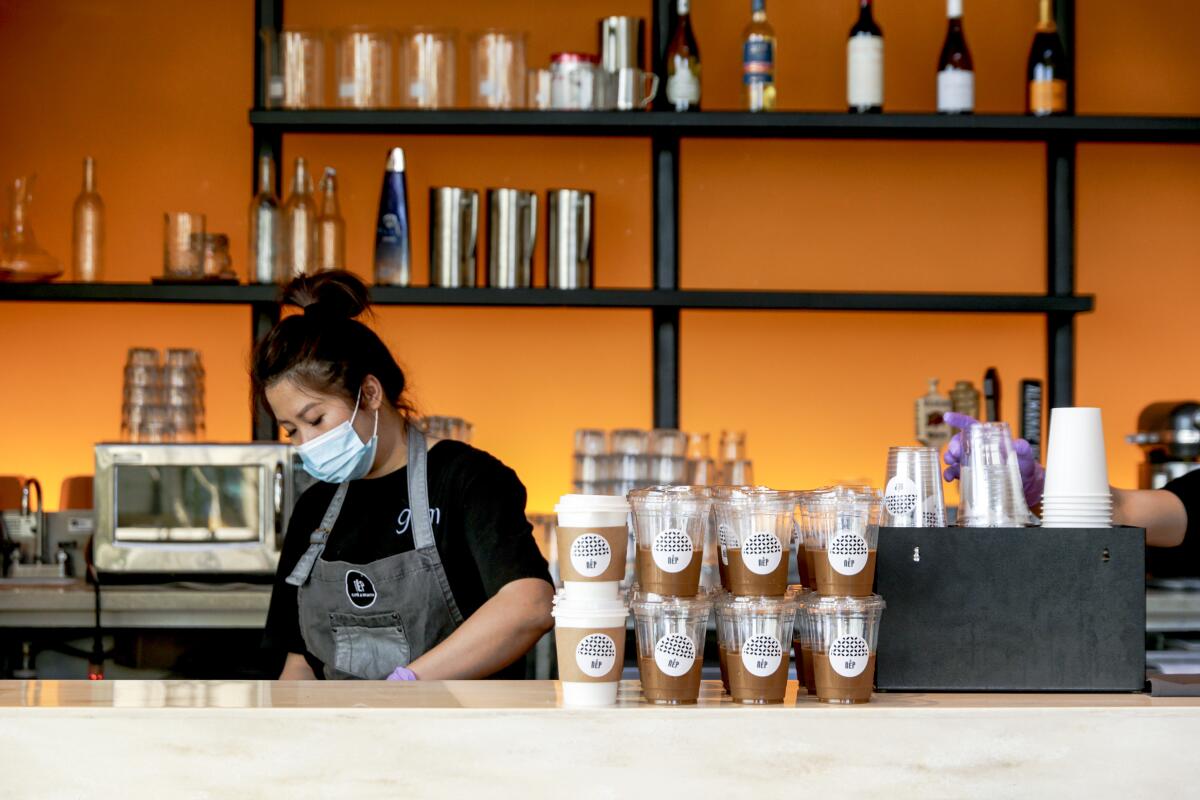
The bestselling drink at Nep Café, and the one dearest to Nguyen’s heart, however, is the Hanoi-style egg coffee.
Known as cà phê trúng, egg coffee is made by furiously whipping egg yolks with condensed milk into a thick sweet custard, dolloped over a glass of strong phin-dripped Robusta. The story goes that it was invented in the 1940s by a resourceful café owner in war-torn Hanoi who was short on canned milk. The rich drink — sweet and creamy enough to be considered dessert — remains a favorite in Northern Vietnam.
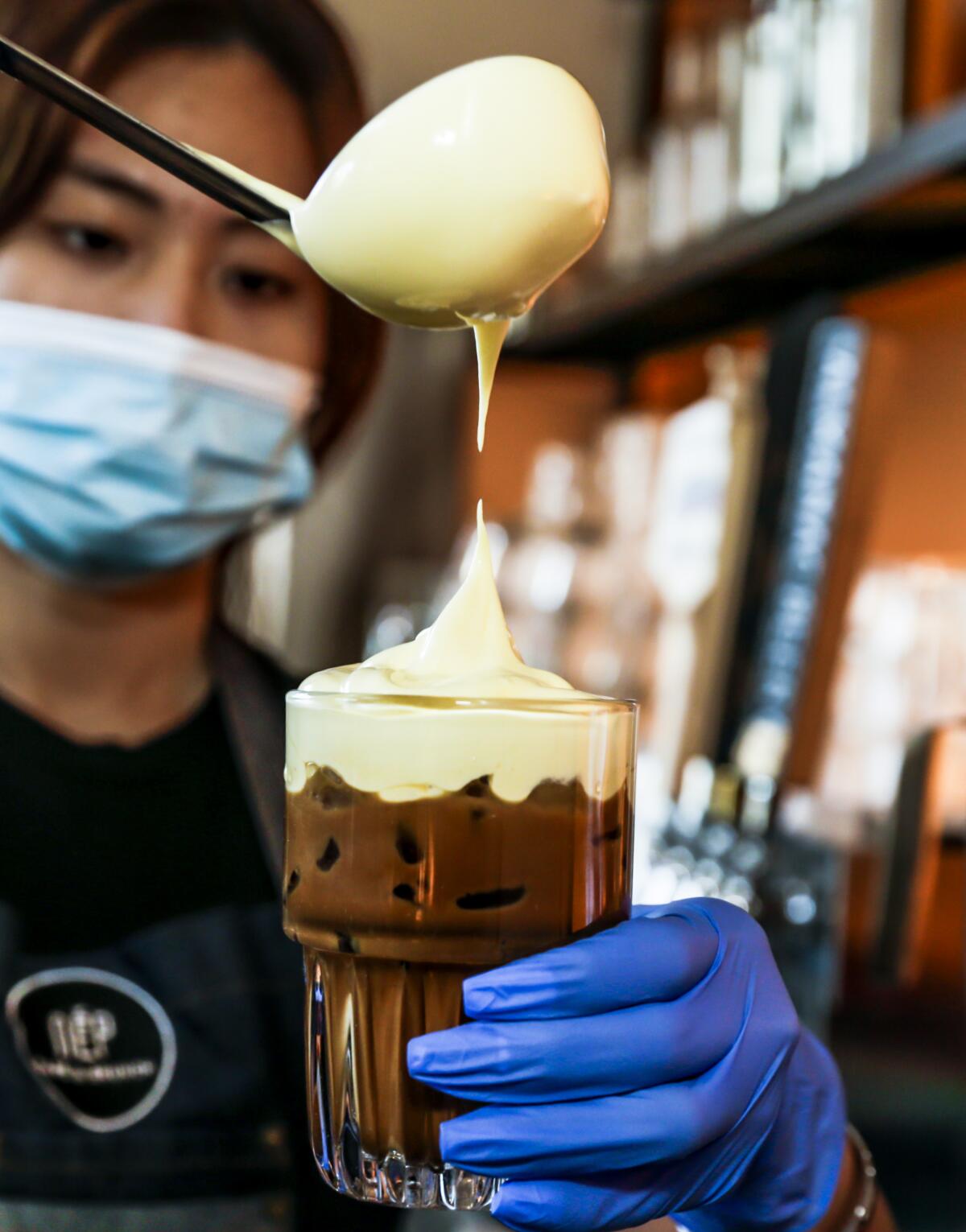
“My father was from the North, so I had tried it there, but I saw that no one was really doing it in the U.S.” said Nguyen. “The super dark coffee flavor with the whipped egg is perfect.”
Nep Café was the first to serve Hanoi-style egg coffee in Southern California, according to Nguyen, but it’s no longer the only. The drink now appears as the house specialty at several recently opened shops, including Airoma Café in Garden Grove and DaVien Cafe & Dessert in Westminster.
Meanwhile, Nep Café has grown into of Orange County’s most popular brunch destinations; the wait for a table often stretches to two hours on weekends.
“When we first opened, I thought, ‘If we get 100 customers in a day, I’ll be happy,’ Nguyen said. “Little did I realize we’d eventually be doing 600, 700 customers just for brunch. That’s crazy.”
Nguyen said that he plans to soon expand Nep Café into a new permanent location, which will be outfitted with an even larger coffee bar. “We have an R&D team dedicated solely to developing new drinks,” he said. “I think the coffee program is a large part of why we’ve been so successful.”
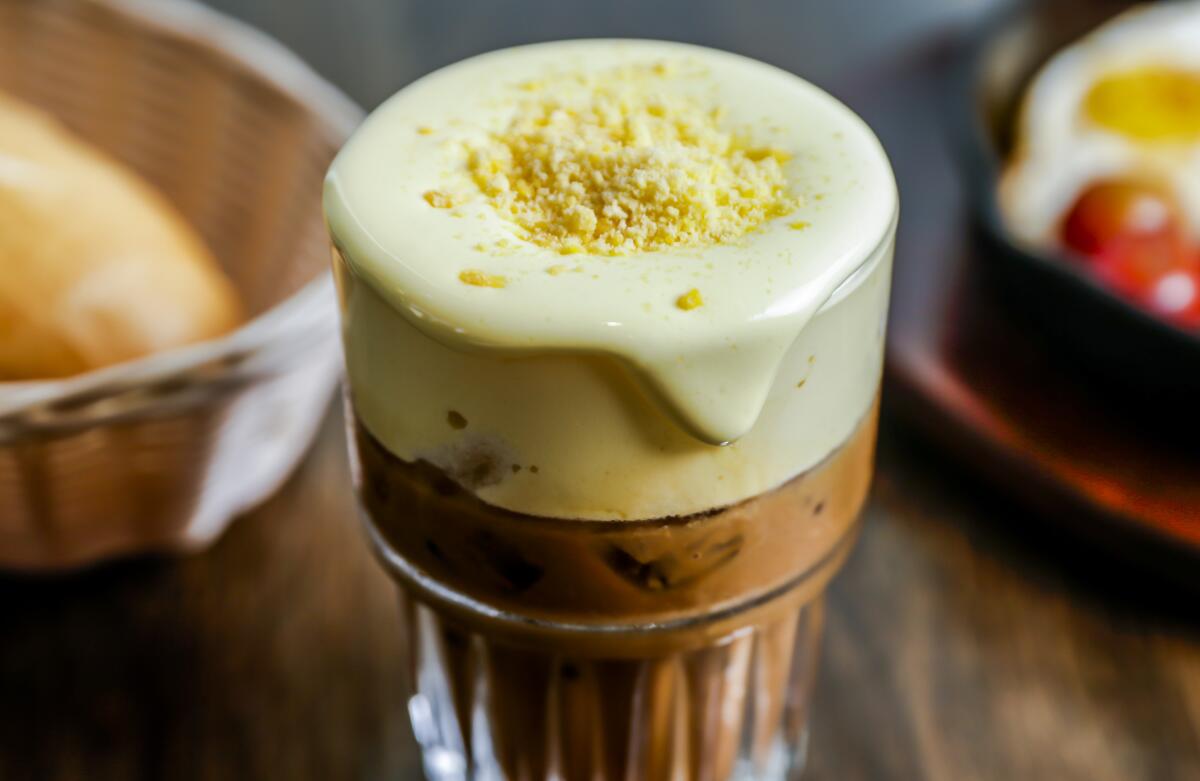
Another recent success story is BLK Dot, a local chain specializing in Vietnamese coffee founded by Mai and Stacie Tran.
The sisters grew up making coffee at their parents’ Vietnamese-Chinese restaurant in Irvine; after years of developing their own proprietary blend of creamers and a “slow-dripped” coffee concentrate, they opened their first location inside the Irvine offices of Google in 2015.
Their flagship coffee — branded as an Iced VTM — quickly became a favorite of tech workers not only for its bold flavor, but it’s high caffeine content.
“People called it ‘crack in a cup,’” said Mai Tran. “We would have trainers from the Equinox gym across the street buy it for their clients because it would make them have a more productive workout.”
The company uses a traditional phin filter to brew its coffee concentrate and roasts the coffee beans it uses in-house, she said, although they prefer to use Arabica beans from South America over Robusta.
“Arabica had more of that dark chocolate note we were looking for,” Tran said.
The secret to great Vietnamese coffee, she believes, is to pack a lot of flavor (and caffeine) into a very small shot: a liquid black hole. “The kind we drank growing up, all you needed was maybe two ounces of extremely strong coffee, then just fill the rest of the cup with ice.”
There are now six locations of BLK Dot across Orange County and Long Beach, and Tran said the company plans to expand further into Los Angeles County in 2022. “We know the culture, we know how it’s supposed to taste, but we’re doing something different and reaching an audience who might not have tried traditional Vietnamese coffee before,” she said.
Creations such as the BLK’nd Mojito, an iced coffee flavored with mint and topped with mojito foam, and the VTMatcha, a colorful layering of creamy Uji matcha and Vietnamese coffee have been particularly popular.
“We have customers that come in and just point to a picture of it on their phone, like ‘I want this,’” said Tran.
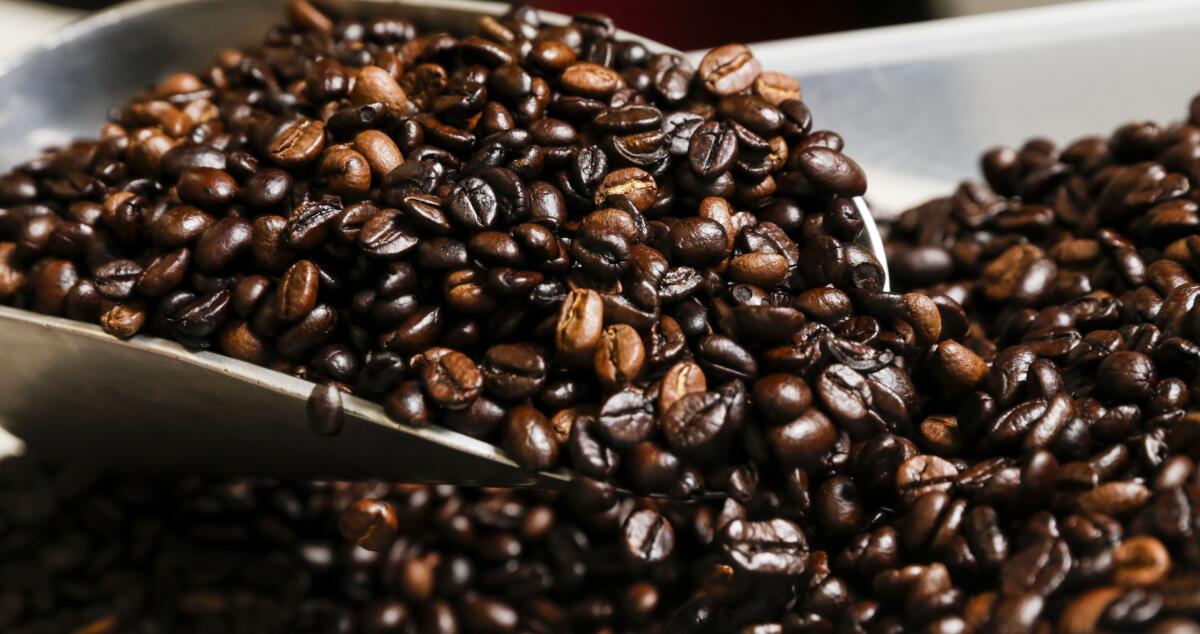
A fast-growing market
If there’s a reason to be bullish about the continued growth of Vietnamese coffee in Southern California, it might be the arrival of two of Vietnam’s widely-known chains.
King Coffee, one of the country’s bestselling brands, opened its first U.S. location at Anaheim GardenWalk in May, selling Vietnamese coffee, egg coffee and banh mi in a shopping complex that is also home to Bubba Gump Shrimp Co. and the Cheesecake Factory.
According to a press release, the company plans to open 100 locations across the U.S. by the end of 2022.
In July, Phuc Long Coffee and Tea, a South Vietnamese chain with over 80 locations in Saigon, opened its first U.S. location in Garden Grove — a storefront directly across the street from Phin Smith.
Despite Phuc Long’s popularity in Vietnam, Viet Do of Phin Smith isn’t too worried about the competition. He’s currently scouting spaces in which to open a second Phin Smith, with more locations potentially on the horizon.
“Most of our business has come from strong word-of-mouth” said Do. “We let the recipes speak for themselves and try to come up with drinks that no one else is doing.”
Although Do and his co-owners at Phin Smith have gone to considerable lengths to import fresh coffee from Vietnam, they’re not staunch traditionalists either.
For customers who find the original cà phê sua dá too strong, Do nudges them toward ordering the drink “Phin-style,” which adds a shot of hazelnut syrup and sea salt foam, a riff inspired by a similar drink at popular Orange County-based chain 7 Leaves Café.
Along with a blended frozen coconut coffee — a riff on a summertime staple in Vietnam — the drink menu at Phin Smith includes a rose-flavored latté and coffee with banana milk. During the holiday season, Do even ran a peppermint cà phê sua dá dusted with candy cane powder as a special.
“For the younger generation [of Vietnamese Americans], I think there’s interest in experimenting with different styles of coffee and incorporating new ideas,” he said.
In a sense, the spirit of creativity sweeping Little Saigon at the moment fits with the larger tradition of coffee in Vietnam: What began as an imposition by the French evolved into a source of national pride and enjoyment, eventually becoming a cultural export of its own.
Not that the appeal of Vietnamese coffee requires that much explanation, especially in balmy Southern California. Sometimes we just crave something strong, sweet and creamy over ice.
More to Read
Eat your way across L.A.
Get our weekly Tasting Notes newsletter for reviews, news and more.
You may occasionally receive promotional content from the Los Angeles Times.


